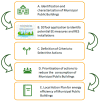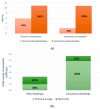How to Prioritize Energy Efficiency Intervention in Municipal Public Buildings to Decrease CO2 Emissions? A Case Study from Italy
- PMID: 32575697
- PMCID: PMC7344483
- DOI: 10.3390/ijerph17124434
How to Prioritize Energy Efficiency Intervention in Municipal Public Buildings to Decrease CO2 Emissions? A Case Study from Italy
Abstract
The European Union 2050 climate neutrality goal and the climate crisis require coordinated efforts to reduce energy consumption in all sectors, and mainly in buildings greatly affected by the increasing temperature, with relevant CO2 emissions due to inefficient end-use technologies. Moreover, the old building stock of most countries requires suited policies to support renovation programs aimed at improving energy performances and optimize energy uses. A toolbox was developed in the framework of the PrioritEE project to provide policy makers and technicians with a wide set of tools to support energy efficiency in Municipal Public Buildings. The toolbox, available for free, was tested in the partners' communities, proving its effectiveness. The paper illustrates its application to the Potenza Municipality case study in which the online calculator DSTool (the core instrument of the toolbox) was utilized to select and prioritize the energy efficiency interventions in public buildings implementable in a three-year action plan in terms of costs, energy savings, CO2 emissions' reduction and return on investments. The results highlight that improvements in the building envelopes (walls and roofs), heating and lighting and photovoltaic systems allow reducing CO2 emission approximately 644 t/year and saving about 2050 MWh/year with a total three-year investment of 1,728,823 EUR.
Keywords: Mediterranean (MED) regions; decision-making support tool; energy efficiency; public buildings energy optimization; public buildings renovation.
Conflict of interest statement
The authors declare no conflict of interest.
Figures





Comment in
-
Reply to Comment on Pietrapertosa et al. How to Prioritize Energy Efficiency Intervention in Municipal Public Buildings to Decrease CO2 Emissions? A Case Study from Italy. Int. J. Environ. Res. Public Health 2020, 17, 4434.Int J Environ Res Public Health. 2021 Apr 4;18(7):3760. doi: 10.3390/ijerph18073760. Int J Environ Res Public Health. 2021. PMID: 33916519 Free PMC article.
-
Comment on Pietrapertosa et al. How to Prioritize Energy Efficiency Intervention in Municipal Public Buildings to Decrease CO2 Emissions? A Case Study from Italy. Int. J. Environ. Res. Public Health 2020, 17, 4434.Int J Environ Res Public Health. 2021 Apr 9;18(8):3961. doi: 10.3390/ijerph18083961. Int J Environ Res Public Health. 2021. PMID: 33918731 Free PMC article.
References
-
- The Paris Agreement | UNFCCC. [(accessed on 30 April 2020)]; Available online: https://unfccc.int/process-and-meetings/the-paris-agreement/the-paris-ag....
-
- European Commission 2030 Climate & Energy Framework. [(accessed on 30 April 2020)]; Available online: https://ec.europa.eu/clima/policies/strategies/2030_en.
-
- International Energy Agency Cities are at the Frontline of the Energy Transition. [(accessed on 30 April 2020)]; Available online: https://www.iea.org/news/cities-are-at-the-frontline-of-the-energy-trans....
-
- United Nation 68% of the World Population Projected to Live in Urban Areas by 2050, Says UN. [(accessed on 30 April 2020)]; Available online: https://www.un.org/development/desa/en/news/population/2018-revision-of-....
Publication types
MeSH terms
Substances
LinkOut - more resources
Full Text Sources

